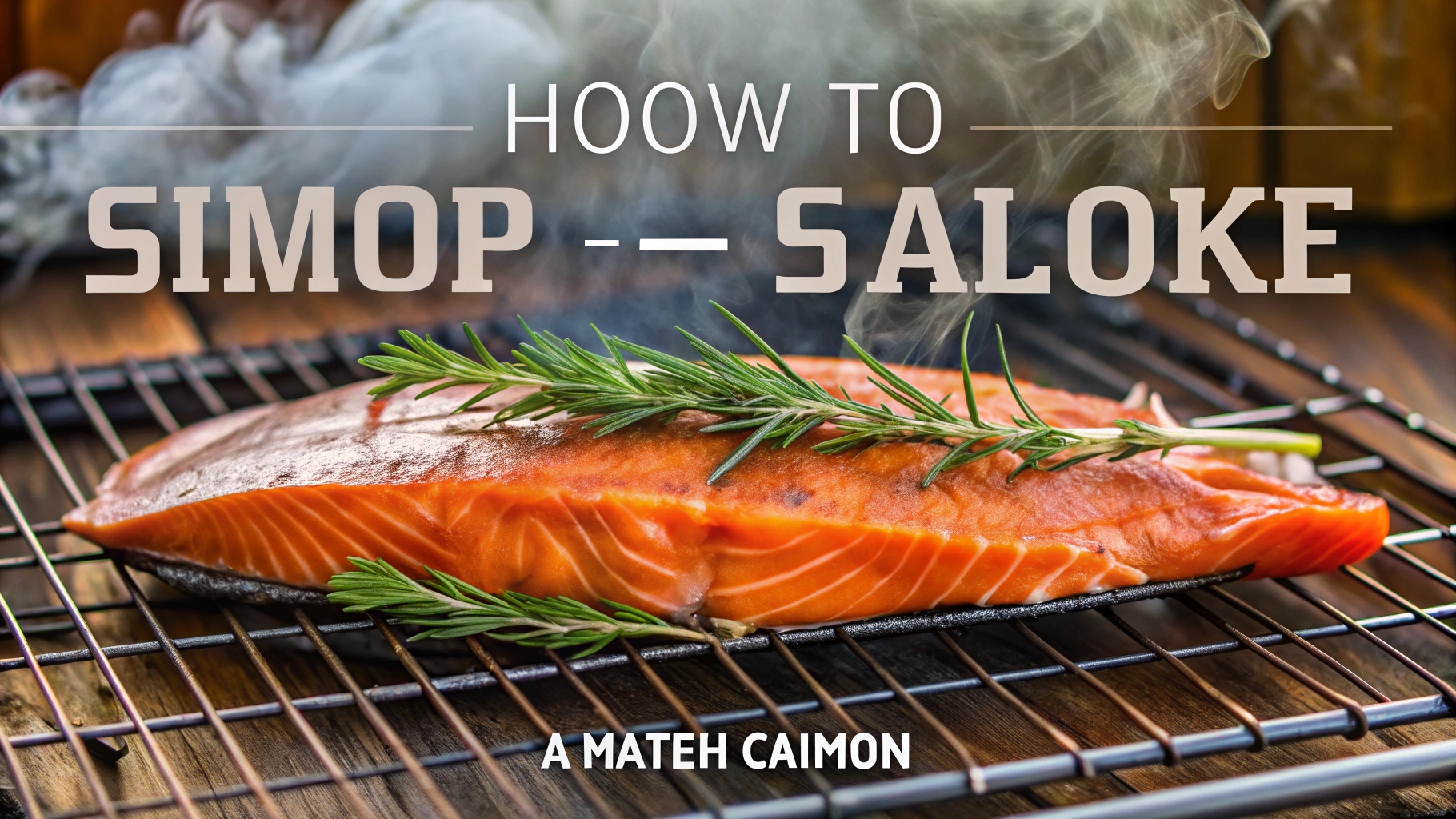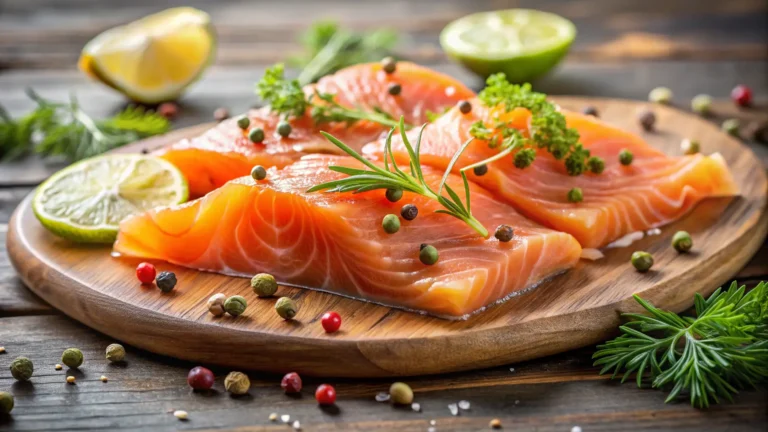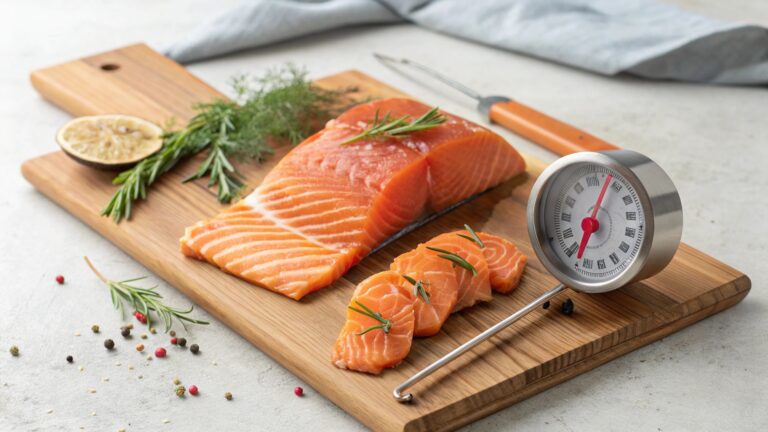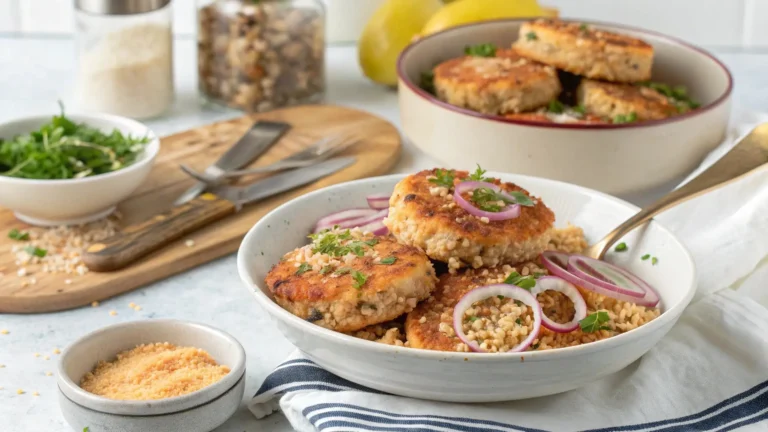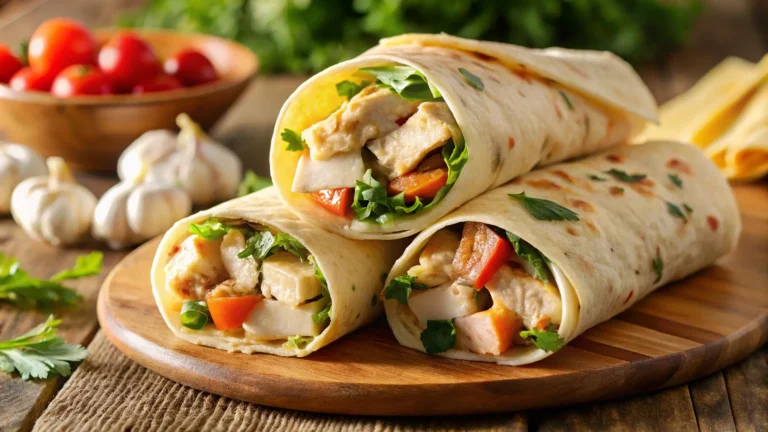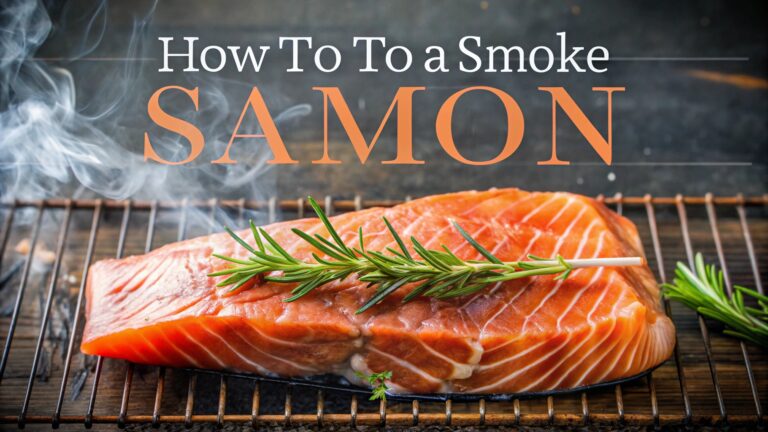How to Smoke Salmon: 7 Simple Steps to Perfection

The first time I mastered smoking salmon in my backyard smoker, it was like magic. Turning fresh salmon into a smoky treat felt like unlocking a secret. It’s a skill passed down through generations.
Learning to smoke salmon is more than just cooking. It’s about connecting with a tradition of preserving food. Whether you’re new to cooking or experienced, smoking salmon impresses everyone.
This guide will show you how to make delicious homemade smoked salmon. You’ll learn about choosing the right fish and controlling temperatures. It’s easier and more rewarding than you think.
Key Takeaways
- Smoking salmon is an accessible culinary skill for home cooks
- Proper preparation is crucial for perfect smoked salmon
- Equipment and technique matter more than complex recipes
- Fresh, high-quality salmon produces the best results
- Practice and patience lead to mastery of smoking techniques
What You Need to Smoke Salmon
To smoke salmon, you need to plan and have the right tools. Start by picking the best smoker for salmon. Then, gather all the necessary tools to turn your kitchen into a pro smoking station.
Starting a smoking salmon recipe means knowing the key parts for success. Let’s look at what you’ll need.
Essential Equipment for Smoking Salmon
- Digital meat thermometer
- Sharp fillet knife
- Large non-reactive brining container
- Cutting board
- Paper towels
- Cooling rack
Types of Smokers
Choosing the right smoker for salmon depends on your style and budget. Each smoker type has its own benefits:
- Electric Smokers: Easy to use, consistent temperature
- Charcoal Smokers: Traditional taste, hands-on
- Pellet Smokers: Convenient, precise control
- Offset Smokers: Big capacity, authentic smoking
Ingredients for Brining
A great smoking salmon recipe starts with a good brine. You’ll need:
- Kosher salt
- Brown sugar
- Water
- Optional spices: Black pepper, garlic powder, dill
“The secret to great smoked salmon is in the preparation and patience.” – Professional Chef
Choosing the right equipment and understanding your smoker is key. It will help you make delicious, restaurant-quality smoked salmon at home.
Choosing the Right Salmon
Choosing the right salmon is key for great smoked salmon. The type of fish you pick affects the taste, texture, and quality of your smoked salmon. Knowing the differences between salmon types can make your smoking skills go from beginner to expert.
Fresh vs. Frozen Salmon
You have two main choices for salmon: fresh or frozen. Fresh salmon gives better texture and taste, especially if you get it from a local fishmonger. Frozen salmon is a good option if it’s of high quality and thawed right.
- Fresh salmon benefits:
- Peak flavor and texture
- Minimal processing
- Ideal for immediate smoking
- Frozen salmon advantages:
- Longer storage potential
- Often more affordable
- Consistent availability
Wild-Caught vs. Farm-Raised Salmon
Think about where your salmon comes from. Wild-caught salmon has a stronger taste and leaner meat. Farm-raised salmon has more fat, making it richer for smoking.
| Characteristic | Wild-Caught Salmon | Farm-Raised Salmon |
|---|---|---|
| Flavor Intensity | Strong, distinctive | Milder, more consistent |
| Fat Content | Leaner | Higher fat percentage |
| Price | Generally more expensive | More budget-friendly |
Sustainable Salmon Options
Choose salmon that’s caught sustainably. Look for the Marine Stewardship Council (MSC) or Alaska Seafood Marketing Institute labels. These show the fish was caught in a way that’s good for the ocean.
- Sustainable salmon indicators:
- MSC blue fish label
- Alaska wild-caught certification
- Responsible aquaculture practices
By picking the right salmon, you’ll get a delicious, top-quality smoked salmon. It will also be good for the planet.
Preparing the Salmon for Smoking
Starting to smoke salmon at home is exciting. It’s all about turning fresh fish into a tasty treat. This dish will wow your guests and let you show off your cooking skills.
Cleaning Your Salmon
First, clean the salmon well. Here’s how:
- Rinse the salmon under cold water
- Remove any remaining scales with a fish scaler
- Pat the fish dry with clean paper towels
- Check for any pin bones using tweezers
Precise Filleting Techniques
Filleting needs sharp knife skills and the right tools. Place the salmon on a clean cutting board. Then, slice along the backbone to separate the meat from bones.
Advanced Brining Methods
Brining is key in making smoked salmon. You have two main methods:
- Wet Brine: Submerge salmon in saltwater solution
- Dry Brine: Coat salmon with salt and sugar mixture
Drying for Perfect Texture
After brining, let the salmon dry. This step is called developing a pellicle. It helps the smoke stick to the fish, giving it a rich flavor. Place the brined salmon on a rack in the fridge for 2-4 hours to dry.
Selecting the Wood for Smoking
Choosing the right wood is key to making tasty smoked salmon. The wood you pick greatly affects the flavor of your dish. It’s important to pick wood that brings out the fish’s taste without overpowering it.

Knowing the unique qualities of different woods will make your smoked salmon stand out. Not all woods are the same when it comes to smoking.
Popular Wood Choices for Smoking Salmon
- Alder Wood: The traditional favorite for smoking salmon, providing a light and subtle flavor
- Apple Wood: Offers a sweet, mild taste that complements the salmon’s natural richness
- Hickory Wood: Delivers a stronger, more robust smoky flavor
- Cherry Wood: Adds a mild, slightly sweet undertone to the fish
Understanding Wood Flavor Profiles
Each wood type adds its own special flavor to smoked salmon. Lighter woods like alder are best for delicate fish. Stronger woods should be used carefully to avoid overpowering the salmon’s taste.
Avoiding Toxic Woods
Some woods are dangerous for smoking and can ruin your salmon or pose health risks. Avoid using:
- Pine
- Cedar
- Spruce
- Elm
Stick to hardwoods specifically recommended for smoking salmon for a safe and tasty result. Your smoked salmon techniques will get better as you try different wood combinations and find your favorite flavor.
Setting Up Your Smoker
Getting your smoker ready is key to making great smoked salmon. The right smoker needs careful setup and attention. Knowing how to smoke salmon well is all about precision and care.
Temperature Control Essentials
Keeping the temperature steady is vital for smoking salmon. Most smokers do best at 180-225°F. Here are some tips for keeping the temperature just right:
- Invest in a digital thermometer with probe
- Place thermometer near the salmon for accurate readings
- Adjust vents to regulate heat flow
- Check temperature every 30 minutes
Enhancing Flavor with Wood Chips
Wood chips can really boost your salmon’s flavor. For the best results, pick wood chips that go well with fish:
- Alder: Traditional salmon smoking wood
- Apple: Mild, sweet flavor
- Maple: Subtle sweetness
- Soak chips in water for 30 minutes before use
Preparing the Smoking Chamber
A clean smoking chamber is essential for even cooking and flavor. Place your salmon with space for smoke to flow. Use a rack or grill mat to prevent sticking and make removal easy.
Pro tip: Clean your smoker thoroughly before each use to prevent unwanted flavors from previous smoking sessions.
Smoking the Salmon
Making a perfect smoked salmon recipe needs careful attention and patience. The smoking process turns fresh salmon into a tasty treat that will wow food lovers.
When smoking salmon, keeping the temperature and timing right is key. The right steps ensure your salmon gets smoky flavors and stays tender and moist.
Timing and Temperature Guidelines
Your smoking salmon recipe needs careful temperature control. Aim for a smoker temperature between 175°F and 200°F. The cooking time depends on the salmon’s thickness:
- Thin fillets: 2-3 hours
- Medium-thick cuts: 3-4 hours
- Thick salmon pieces: 4-5 hours
Monitoring the Smoking Process
Getting perfect smoked salmon means watching it closely. Use a meat thermometer to check the internal temperature. The salmon is done when it hits 145°F and looks golden-brown.
Ensuring Even Cooking
To make sure the salmon smokes evenly, follow these tips:
- Rotate salmon pieces every hour
- Use a rack for better air flow
- Keep your smoker’s heat zones consistent
Pro tip: Pat your salmon dry before smoking. This helps create a beautiful pellicle that boosts smoke absorption and flavor.
Testing for Doneness
To get perfect smoked salmon, you need to watch for a few important signs. Learning these tips will help you make a dish that wows everyone.
Visual Cues of Perfectly Smoked Salmon
The look of your smoked salmon is key. Here’s what to look for:
- A rich, amber to deep orange color
- Translucent flesh that appears slightly glossy
- White protein (albumin) patches on the surface
- Salmon that looks moist but not wet
Internal Temperature Guidelines
Checking the internal temperature is the best way to know if your salmon is done. Chefs say to aim for:
- 145°F (63°C) for fully cooked salmon
- Use a digital meat thermometer for accuracy
- Insert the thermometer into the thickest part of the fillet
Texture: The Final Test
Texture is also important. Your smoked salmon should:
- Flake easily with a fork
- Feel tender and not rubbery
- Have a smooth, silky consistency
By following these tips, you’ll get a tasty result every time. Remember, the more you practice, the better you’ll get at making perfect smoked salmon.
Cooling and Storage
After smoking salmon at home, it’s important to cool and store it right. This keeps your dish tasty and safe to eat. The right steps will lock in the flavors and stop bacteria from growing.

Cooling Your Smoked Salmon Safely
After smoking, let the salmon cool down slowly. Place it on a clean rack to cool evenly. This step sets the smoky taste and keeps the salmon’s texture just right.
Best Storage Practices
Storing smoked salmon correctly is key to keeping it fresh. Here’s what to do:
- Wrap the cooled salmon tightly in plastic wrap or vacuum-sealed bags
- Store in the refrigerator at 38-40°F (3-4°C)
- Consume within 3-5 days for optimal freshness
- Use airtight containers to prevent flavor absorption from other foods
Freezing for Long-Term Preservation
Smoking salmon at home lets you keep it for months. When freezing:
- Wrap the salmon in moisture-proof freezer paper
- Use vacuum-sealed bags to prevent freezer burn
- Label with the date of smoking
- Store in the freezer for up to 3 months
To thaw, let it thaw slowly in the fridge overnight. This keeps the salmon’s texture and flavor perfect.
Serving Suggestions
Once you’ve mastered the art of smoked salmon, you’ll want to serve it in the most appealing ways. Your perfectly smoked salmon can make any meal special, whether it’s casual or fancy.
Smoked salmon opens up a world of creative serving ideas. Here are some fun ways to enjoy your tasty fish:
- Classic Appetizers: Make elegant canapés with thin smoked salmon slices on crackers or cucumber rounds
- Breakfast Favorites: Top bagels with cream cheese and smoked salmon for a traditional morning treat
- Salad Enhancements: Flake smoked salmon over mixed greens for added protein and flavor
- Pasta Dishes: Add chunks of smoked salmon to creamy pasta recipes
Pairing with Side Dishes
Choosing the right sides can make your smoked salmon even better. Try these side dishes:
- Dill-infused potato salad
- Crisp cucumber and herb salad
- Roasted asparagus with lemon
- Light grain salads like quinoa or couscous
Presentation Tips
Make your smoked salmon look amazing with these tips. Arrange thin slices in elegant patterns, add fresh herbs, and use white plates. For fancy events, serve on slate boards or decorative platters.
Creative Serving Ideas
Try new ways to serve your smoked salmon. Roll it into pinwheels, make salmon tartare, or use it in fancy appetizers. These ideas will wow your guests and show off your cooking skills.
Troubleshooting Common Issues
Smoking salmon at home can be tricky, even for experts. Knowing common problems helps you make perfect smoked salmon. Here are some tips to help you improve your smoking skills.
Smoking salmon at home can lead to several issues. Spotting these problems early lets you fix them quickly. This keeps your smoked fish tasting great.
Preventing Overcooked Salmon
Overcooked salmon is dry and loses its flavor. To prevent this, follow these steps:
- Use a reliable meat thermometer
- Monitor internal temperature closely
- Remove salmon from heat when it reaches 145°F
- Let the fish rest for 5-10 minutes after smoking
Addressing Unwanted Flavors
Off-flavors can ruin your smoked salmon’s taste. Knowing where these flavors come from helps you avoid them:
| Flavor Issue | Potential Cause | Solution |
|---|---|---|
| Bitter Taste | Excessive smoke exposure | Reduce wood chip quantity |
| Chemical Flavor | Low-quality wood chips | Use premium hardwood chips |
| Metallic Taste | Improper cleaning of smoker | Thoroughly clean smoker between uses |
Achieving Consistent Smoke Flavor
Inconsistent smoke flavor can make your salmon taste uneven. Here are ways to ensure even flavor:
- Maintain steady smoker temperature
- Use a water pan to regulate heat
- Rotate salmon midway through smoking
- Select high-quality wood chips
Remember, practice makes perfect when smoking salmon at home. Each attempt brings you closer to mastering this delicious culinary skill.
Conclusion: Enjoying Your Smoked Salmon
Learning to smoke salmon is a fun journey that turns simple fish into a tasty treat. You’ll soon be able to make smoked salmon as good as any restaurant’s. This skill lets you explore new flavors and dishes.
When you share your smoked salmon, you’ll feel proud and happy. The smoky taste you’ve worked on will wow your family and friends. It shows off your cooking skills and adds to your home’s culinary charm.
Keep practicing and don’t be afraid to try new things. Start with the basics and then experiment with different woods, brines, and spices. With each try, you’ll get better and enjoy the process more.
See this skill as a chance to be creative and connect with others. Use your smoked salmon to impress at parties, make a fancy breakfast, or just share a special meal. It’s a sign of your hard work and love for cooking.

